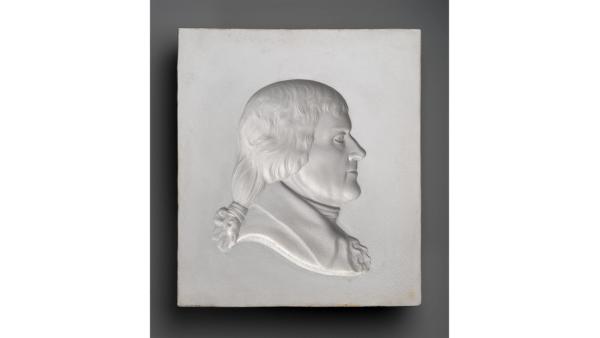About the Audio Guide
Behind every artwork in the American Wing are often surprising stories of identity, time, and place. Hear historians, artists, poets, and community leaders from diverse backgrounds offer perspectives on various works. Narrated by Danielle Parker.
Learn more about the contributors.

4001. Thomas Jefferson, Charles l. Hogeboom, (by 1884)
NARRATOR: Thomas Jefferson and Benjamin Franklin appear in these late nineteenth-century plaster reliefs as we are typically used to seeing them—as heroic figures.
Jane Kamensky, president and CEO of the Thomas Jefferson Foundation.
JANE KAMENSKY:We see in both the Franklin and the Jefferson images a kind of serenity. A serenity that almost resists life.These are figures beyond mortality.
NARRATOR: These sculptures suggest an America eager to reunite with a common, more harmonious origin story in the years after the Civil War. The Colonial Revival cultural phenomenon, which valued the founding narratives of the United States, was one such avenue to shared history and memory.
JANE KAMENSKY: I think the Colonial Revival Movement in arts, literature, the decorative arts, is part of an effort at national healing, in the wake of a civil war, and also an effort to tell a common American story in a period of massive social and demographic disruption.
The words that Jefferson wrote in the Declaration ofIndependence: We hold these truths to be self-evident, that all men, meaning all humanity, were created equal, these were words that women seeking suffrage embraced in the 19th-century, they were words that Frederick Douglass wrestled with, they were words that Gandhi took up, that have literally made their way around the globe. At the same time, Jefferson was an enslaver of hundreds of human beings; 600 or so over the course of his lifetime. So, there’s a tremendous contradiction baked into the history of this most brilliant and polymathic of American founders. That contradiction was known at the time was known especially by Jefferson, who knew that slavery was wrong. In our memorializations of the founders, we stopped wrestling with those contradictions and started remembering marble men, right?
An important thing to remember about America’s founders is that they did not view themselves as marble men. They viewed themselves as fallible human beings, as indeed they were.
Playlist
Contributors
Renée Barry Independent Critical Environmental Researcher
Xiye Bastida Climate Activist
Christopher Benfey Cultural Critic
Dawoud Bey Artist
Vincent Brown Charles Warren Professor of American History and Professor of African and African American Studies, Harvard University
dann j. Broyld Associate Professor of African American History, University of Massachusetts Lowell
Colin Calloway Professor of History and Native American and Indigenous Studies, Dartmouth College
Patricia Cronin Artist and Distinguished Professor of Art, Brooklyn College, CUNY
Nika Elder Associate Professor of Art History, American University
Sherrie Smith Ferri (Dry Creek Pomo/Bodega Miwok) Tribal Historic Preservation Officer; Former Director and Curator, Grace Hudson Museum
Michael Galban Director, Seneca Art & Culture Center, Ganondagan State Historic Site
Christine Garnier Assistant Professor of Art History, University of California, Santa Barbara
Carolyn Guzski Associate Professor of Musicology, SUNY-Buffalo State University
Hugh Hayden Artist
Daniel Immerwahr Berger Evans Professor in Humanities, Northwestern University
Jane Kamensky President and CEO, Thomas Jefferson Foundation
Titus Kaphar Painter, Sculptor, and Filmmaker
Lauranett Lee Public Historian, Richmond, Virginia
Glenn Ligon Artist
Katherine Manthorne Professor Emerita of Art History, CUNY Graduate Center
Johanna Obenda Cultural Practitioner and Curatorial Specialist
Najee Omar Poet, Performer, and Organizer
Varsha Panjwani NYU London lecturer and creator-host of “Women and Shakespeare” podcast
Anna Plesset Artist
Kathleen Pyne Professor Emerita of Art History, University of Notre Dame
Jolene Rickard (Tuscarora Nation) Associate Professor of History of Art and Visual Studies, Cornell University
Gwendolyn DuBois Shaw Class of 1940 Bicentennial Associate Professor of History of Art, University of Pennsylvania
Scott Manning Stevens (Akwesasne Mohawk) Associate Professor and Director of Native American and Indigenous Studies, Syracuse University
Karen Strickland Genealogist and Public Historian, Richland County Public Library, Columbia, South Carolina
Lemir Teron Associate Professor in the Department of Earth, Environment, and Equity, Howard University
Pat Thomas Zoologist
Joseph Zordan (Bad River Ojibwe) PhD Candidate in History of Art and Architecture, Harvard University
